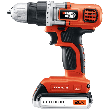When beginning any wood working restoration project then testing for oil or water based finishes should one of the first things that you do. The reason for this is that each kind of finish or paint will require a different method for removal. If you try to use the wrong kind of removal method, while you may not actually ruin the wood, you can at the very least ruin the effect that you are going for. This doesn't even mention the fact that you will end up wasting all kinds of time by using the wrong kind of removal method.
Here are a few simple tests that you can use to help determine whether you have a water based, or an oil based finish. Each of these methods are things that you should be able to do with the materials that you already have in the house. If you don't have these materials in your home already, then a quick trip to your local department store will quickly get you back on track.

MAX Power! A powerful lithium-ion drill/driver that delivers 0-to-650 RPM and 115 inches-per-pound of torque in a lightweight, easy-to-use package. An anti-slip soft grip and LED worklight makes this tool a delight to use. Check out Black & Decker 20-Volt Cordless Drill/Driver today!
Whatever type of paint sprayer you chose, make sure that you follow all of the manufacturer's directions for use and ...
Discover MoreWhile everyone may know that lead based paint isn't exactly the best, do you know why testing for lead paint is so ...
Discover MoreDetermining the budget of a renovation project is perhaps the single most important part of any project. Perhaps one of ...
Discover More2018-08-13 21:01:44
Stelzer Painting Inc.
You have it backwards: Oil-based stains penetrate deeper than water-based stains. It's the water-based stains which rest more on the surface. You cannot necessarily tell the stain by the feel, but I suspect what you might instead be referring to is the fact that water-based stains will raise the grain, creating a rougher texture, so in that regard, you're correct. The manner in which water beads off the surface is much more likely to be associated with whether it's ready to be re-stained vs. whether the stain is still able to repel water.
2014-08-18 11:24:14
Sue
I have an unmarked can of stain which was used on my cupboards. How can I tell if the stain is oil or water based. I want to finish some pine frames with it and I need to know so I can purchase the proper wood conditioner. Thank you
2014-03-05 13:34:40
Ladona
Thank you! This is exactly what I needed. The walls in our cabin are stained and I need to match. Step one was to figure out if I should start with oil or water based stains. This will save me hours!
2013-07-19 19:17:15
Norm
Are these tips for stain or finish? The title indicates for finish, but the discussions are all about stain. For example, on water beads...even if the stain was water based, if there is a finish like poly or lacquer, etc then it will bead up. I want to know how to tell if the finish is water or oil based; not concerned about the stain, yet.
Copyright © 2024 Sharon Parq Associates, Inc.
Comments